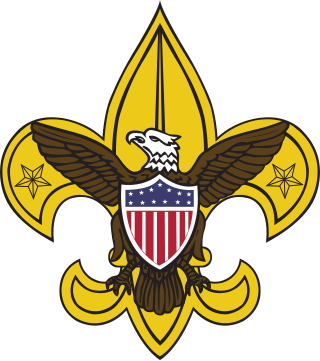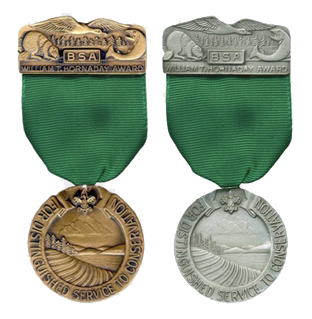
The Boy Scouts of America is one of the largest scouting organizations and one of the largest youth organizations in the United States, with about 762,000 youth participants. The BSA was founded in 1910; about 110 million Americans have participated in its programs. BSA became a founding member organization of the World Organization of the Scout Movement in 1922.

The Order of the Arrow (OA) is the honor society of the Boy Scouts of America (BSA), composed of Scouts and Scouters who best exemplify the Scout Oath and Law in their daily lives as elected by their peers. The society was created by E. Urner Goodman, with the assistance of Carroll A. Edson, in 1915 as a means of reinforcing the Scout Oath and the Scout Law.

Eagle Scout is the highest rank attainable in the Scouts BSA program by the Boy Scouts of America (BSA). Since its inception in 1911, only four percent of Scouts have earned this rank after a lengthy review process. The Eagle Scout rank has been earned by over 2.5 million youth.

Cub Scouting is part of the Scouting program of the Boy Scouts of America (BSA), available to boys and girls from kindergarten through fifth grade, or 5 to 10 years of age and their families. Its membership is the largest of the five main BSA divisions. Cub Scouting is part of the worldwide Scouting movement and aims to promote character development, citizenship training, personal fitness, and leadership.

A variety of religious emblems programs are used by the Boy Scouts of America (BSA) to encourage youth to learn about their faith and to recognize adults who provide significant service to youth in a religious environment. These religious programs are created, administered and awarded by the various religious groups, not the BSA, but each program must be recognized by the BSA.

Sea Scouts is a program of the Boy Scouts of America for young men and women ages 14 through 20.

The Boy Scouts of America (BSA) use uniforms and insignia to give a Scout visibility and create a level of identity within both the unit and the community. The uniform is used to promote equality while showing individual achievement. While all uniforms are similar in basic design, they do vary in color and detail to identify the different membership divisions of Cub Scouting, Scouts BSA and Venturing. Many people collect BSA insignia such as camporee and jamboree emblems, council shoulder strips and historical badges.
The Boy Scouts of America (BSA), one of the largest private youth organizations in the United States, has policies which prohibit those who are not willing to subscribe to the BSA's Declaration of Religious Principle, which has been interpreted by some as banning atheists, and, until January 2014, prohibited all "known or avowed homosexuals", from membership in its Scouting program. The ban on adults who are "open or avowed homosexuals" from leadership positions was lifted in July 2015.

The World Scout Emblem is the emblem of the World Organization of the Scout Movement and is worn by Scouts and Scouters around the world to indicate their membership. Each national Scout organization determines the manner in which the emblem is worn.

Scouts BSA is the flagship program and membership level of the Boy Scouts of America (BSA) for boys and girls between the ages of typically 11 and 17. It provides youth training in character, citizenship, and mental and personal fitness. Scouts are expected to develop personal religious values, learn the principles of American heritage and government, and acquire skills to become successful adults.
Religious emblems programs also called religious recognition programs are awards set up by some religious organizations for members of various youth organizations.

The Boy Scouts of America (BSA) was inspired by and modeled on The Boy Scouts Association, established by Robert Baden-Powell in Britain in 1908. In the early 1900s, several youth organizations were active, and many became part of the BSA.

The Silver Beaver Award is the council-level distinguished service award of the Boy Scouts of America. Upon nomination by their local Scout council and with the approval of the National Court of Honor, recipients of this award are registered adult leaders who have made an impact on the lives of youth through service given to the council. The Silver Beaver is an award given to those who implement the Scouting program and perform community service through hard work, self-sacrifice, dedication, and many years of service. It is given to those who do not seek it.

Square knot insignia are embroidered cloth patches that represent awards of the Scout associations throughout the world.

The William T. Hornaday Awards were a series of awards presented by the Boy Scouts of America for service in conservation and ecology. The program is designed to encourage learning about natural resource conservation and the environment, teach sound stewardship of the natural resources and the environment, and recognize those who are outstanding in this field. Considered to be the highest service award a youth could earn in the Boy Scouts, it was a rare and highly prized medal, with only 1,200 medals being awarded in its more than 100 year history. In an effort to distance itself from the controversial history of Dr. Hornaday, the Boy Scouts of America formally retired the William T. Hornaday awards in October of 2020, creating the BSA Distinguished Conservation Awards in its place.

The Quartermaster Award is the highest rank attainable in the Sea Scouting program of the Boy Scouts of America.

Scouts for Equality (SFE) is an American advocacy organization that advocates for equal treatment within the Boy Scouts of America (BSA) for all scouts and scout leaders, regardless of sexual orientation. On July 17, 2012, the BSA reaffirmed a policy, first established in 1991, which prohibited "known or avowed" gay scouts and scout leaders from participating in the organization.

The Venturing Summit is the highest rank for youth in the Venturing program of the Boy Scouts of America. It requires Venturers to earn the Pathfinder Rank, participate in adventures, and demonstrate leadership, service and personal growth.
The emblem of the International Spirit Award is worn as a temporary patch by both youth and adult leaders in the Boy Scouts of America. The award recognizes those who have broadened their knowledge of international Scouting and increased their appreciation and awareness of different cultures and countries. This award replaces the International Activity Patch (1991-2012).

Scout's Honor is a 2001 American documentary film directed by Tom Shepard and written by Meg Moritz. Appearing as themselves in the documentary are Steven Cozza, James Dale, Tim Curran, Dave Rice and Scott and Jeanette Cozza. The film examines the Boy Scouts of Americas (BSA) policy against gays in the organization. It focuses on Steve Cozza and Dave Rice who join together to fight against the policy, and also relates the stories of two gay men who were expelled from the organization, and fought back in the courts. The film premiered at the Sundance Film Festival on January 25, 2001, where it won an Audience Award for Best Documentary, and director Tom Shepard won a Freedom of Expression Award. The documentary had additional screenings at several other film festivals where it received multiple awards, and it also received a GLAAD Media Award for Outstanding Documentary. The film aired nationally on the PBS series POV on June 19, 2001.

















